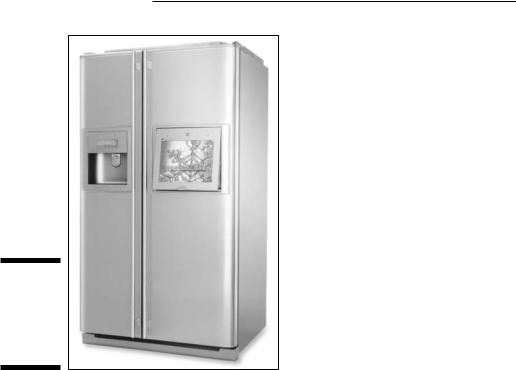
- •About the Authors
- •Dedication
- •Contents at a Glance
- •Table of Contents
- •Introduction
- •About This Book
- •System Requirements
- •How This Book Is Organized
- •Part I: Wireless Networking Fundamentals
- •Part II: Making Plans
- •Part III: Installing a Wireless Network
- •Part IV: Using a Wireless Network
- •Part V: The Part of Tens
- •Icons Used in This Book
- •Where to Go from Here
- •Nothing but Net(work): Why You Need (Or Want) One
- •File sharing
- •Printer and peripheral sharing
- •Internet connection sharing
- •Home arcades and wireless to go
- •Wired versus Wireless
- •Installing wired home networks
- •Installing wireless home networks
- •Picking a Wireless Standard
- •Planning Your Wireless Home Network
- •Workstations and servers
- •Network infrastructure
- •Network interface adapters
- •Get the (Access) Point?
- •Industry Standards
- •Who or What Is Bluetooth?
- •Wi-Fi versus Bluetooth
- •Piconets, Masters, and Slaves
- •Wirelessly synching your PDAs
- •Wireless printing and data transfer
- •Integrating HPNA and HomePlug with Your Wireless Home Network
- •Home Phoning (ET Got It Backward!)
- •Network Power(line)!
- •Deciding What Is Connected to the Network
- •Counting network devices
- •Choosing wired or wireless
- •Choosing a wireless technology
- •Choosing an access point
- •Deciding where to install the AP
- •Adding printers
- •Adding entertainment and more
- •Connecting to the Internet
- •Budgeting for Your Wireless Network
- •Pricing access points
- •Pricing wireless network adapters
- •A sample budget
- •Planning Security
- •Selecting Access Points
- •Certification and Standards Support
- •Compatibility and Form Factor
- •DHCP servers
- •Gateways, NAT, and cable/DSL routers
- •Switches
- •Print servers
- •Operational Features
- •Security
- •Range and Coverage Issues
- •Manageability
- •Web-based configuration
- •Software programming
- •Telnetting to your device
- •Upgradeable firmware
- •Price
- •Warranties
- •Customer and Technical Support
- •Before Getting Started, Get Prepared
- •Setting Up the Access Point
- •Preparing to install a wireless AP
- •Installing the AP
- •Configuring AP parameters
- •Changing the AP Configuration
- •Installing device drivers and client software
- •PC Cards and mini-PCI cards
- •Compact Flash cards
- •PCI and ISA cards
- •USB adapters
- •Modifying Wireless Network Adapters
- •Synchronizing and Internet Access
- •Wireless Zero Configuration with XP
- •Easy installation
- •Automatic network connections
- •Tracking Your Network’s Performance
- •Apple AirPort Hardware
- •Pick an AirPort Card, any card
- •Apple AirPort Software Updates
- •AirPort 2.0 software
- •AirPort 2.0.4 software
- •AirPort 2.0.5 software
- •AirPort 2.1.1 software
- •OS 9 Wireless Networks
- •Installing AirPort software on Mac OS 9
- •Upgrading AirPort Base Station firmware on OS 9
- •OS X Wireless Networks
- •Installing the AirPort software on OS X
- •Upgrading AirPort Base Station firmware on OS X
- •Adding another computer to your AirPort network on OS X
- •Connection sharing
- •Routers and gateways
- •Sharing dialup Internet connections
- •Obtaining an IP Address Automatically
- •Windows 9x
- •Windows 2000
- •Windows XP
- •Setting Up Internet Connection Sharing
- •Windows 98 SE and Windows Me
- •Windows 2000
- •Windows XP
- •Mac OS X v. 10.2 (Jaguar)
- •Assessing the Risks
- •General Internet security
- •Airlink security
- •How about a bit more about WEP?
- •What’s wrong with WEP?
- •Clamping Down on Your Wireless Home Network’s Security
- •Getting rid of the defaults
- •Enabling WEP
- •Closing your network
- •Looking into the Crystal Ball
- •Waiting for WPA
- •The future: 802.11i
- •A Networking Review
- •Basic networking terminology
- •Setting up a workgroup
- •Will You Be My Neighbor?
- •Sharing a document or folder on Windows 95/98/Me
- •Enabling sharing on Windows 2000/XP
- •Setting permissions
- •Accessing shared files
- •Be Economical: Share Those Peripherals
- •Setting up a print server
- •Sharing other peripherals
- •PC Gaming Hardware Requirements
- •Networking Requirements for PC Gaming
- •Console online gaming services and equipment
- •Console wireless networking equipment
- •Dealing with Router Configurations
- •Getting an IP address
- •Dealing with port forwarding
- •Setting Up a Demilitarized Zone (DMZ)
- •Wireless Home Entertainment Gear
- •Expanding Your Home Entertainment Center with Wireless Adapters
- •The Home Media Player
- •The Home Theater PC
- •Internet Content for Your Media Players and HTPCs
- •Making a Connection to Your Car
- •Your car’s path to wireless enlightenment
- •Synching your car stereo with home
- •Getting online with your own car PC
- •Picking wireless gear for your car
- •Using your PDA as a remote control
- •Whole home 802.11-based IR coverage
- •See me, feel me, hear me, touch me
- •Discovering Bluetooth Basics
- •Bluetooth Mobile Phones
- •Bluetooth PDAs
- •Other Bluetooth Devices
- •Printers
- •Digital cameras
- •Keyboards and meeses (that’s plural for mouse!)
- •Bluetooth adapters
- •Discovering Public Hot Spots
- •Freenets and open access points
- •For-pay services
- •Using T-Mobile Hot Spots
- •Using Wayport Hot Spots
- •Using Boingo Hot Spots
- •Tools for Finding Hot Spots
- •Netstumbler.com
- •Boingo
- •Check the Obvious
- •Move the Access Point
- •Move the Antenna(s)
- •Change Channels
- •Check for Dual-Band Interference
- •Check for New Obstacles
- •Install Another Antenna
- •Add a Signal Booster
- •Add a Repeater or Bridge
- •Check Your Cordless Phone Frequencies
- •Your Bath
- •Your Car
- •Your Exercise Gear
- •Your Home Appliances
- •Your Musical Instruments
- •Your Pets
- •Your Phones
- •Your Robots
- •Your Wearing Apparel
- •CNET.com
- •802.11 Planet
- •Broadband Wireless Exchange Magazine
- •80211b.weblogger.com
- •PC Magazine
- •Electronic House Magazine
- •Home Automation Magazine
- •Practically Networked
- •ExtremeTech.com
- •Network World
- •Other Cool Sites
- •Index

330 Part V: The Part of Tens
Figure 19-1:
LGE’s Internet Refrigerator is wirelessly enabled.
And with the developments in radio frequency identification (RFID) and other technologies, you might indeed get to the point where your kitchen monitors all of its appliances (and what’s in them — “We need more milk.”).
Your Musical Instruments
A wireless home backbone will enable fast access to online music scores, like from www.score-on-line.com. Musical instruments are also growing more complex and wireless.
With ConcertMaster from Baldwin Piano (www.baldwinpiano.com), your home wireless LAN can plug into your ConcertMaster-equipped Baldwin, Chickering, or Wurlitzer piano and play almost any musical piece that you can imagine. You can plan an entire evening of music, from any combination of sources, to play in any order — all via a wireless RF remote control.
The internal ConcertMaster Library comes preloaded with 20 hours of performances in five musical categories, or you can create up to 99 custom library categories to store your music. With up to 99 songs in each category, you can conceivably have nearly 50,000 songs onboard and ready to play. Use your

Chapter 19: More Than Ten Devices . . . 331
wireless access to your home’s Internet connection to download the latest operating system software from Baldwin’s servers, too. The system can accept any wireless MIDI interface. Encore!
You can record on this system, too. A one-touch Quick-Record button
lets you instantly save piano performances, such as your child’s piano recital. You can also use songs that you record and store on floppy disk with your PC to use within editing, sequencing, and score notation programs.
Your Pets
GPS-based tracking services can be used for pets, too! Just about everyone can identity with having lost their pet at some point. The GPS device’s form factor can be collar-based or a subdermal implant. This can serve as your pet’s electronic ID tag; it also can serve as the basis for real-time feedback to the pet or its owner, perhaps providing automatic notification if your dog goes out of the yard, for instance.
Check out www.homeagainid.com to find out about an Applied Digital-driven service for tracking your pet today. What makes this interesting is making the wireless connection more active than passive, adding 802.11 and GPS technologies so that there can be an ever-present signal to track your pet within the service area. Several companies are testing such capabilities so that soon, your LAN may indeed be part of a neighborhood wireless network infrastructure that provides a NAN — neighborhood area network — one of whose benefits is such continual tracking capability.
Your Phones
True, many phones in homes today are wireless. (And, of course, cell phones are, too.) But remember that your wireless home network uses the same 2.4 GHz and 5.8 GHz wireless frequencies that your cordless phones do. And when you factor in that your neighbor’s phones and a bunch of other devices in home are also on these frequencies, the throughput and usability of your wireless home networking system can get watered down pretty fast.
Enter your whole home 802.11 network. It makes sense to migrate your cordless phones, for instance, to your home wireless network so that your wireless phones won’t compete and interfere with your home wireless network; instead, you can get 802.11-based phones that ride over the same network in a very seamless way. (Chapter 2 has all the details about the 802.11 protocol.)

332 Part V: The Part of Tens
To do this, you will need to get an 802.11-enabled phone, which would work exactly like a cordless phone. In fact, you scarcely could tell the difference between the two. There are only a few such phones available today, and they are fairly pricey, but soon, you’ll probably see a lot more home telephone products that support 802.11. You might also see 802.11 technology bundled inside your cell phone as well, although the early moves with cellular have focused on Bluetooth enablement, which we talk about in Chapter 15.
You can find 802.11b-based business phones today from Symbol Technologies (www.symbol.com) or SpectraLink (www.spectralink.com), but these are more business class products and require business telephone gear and VoIP (Voice over IP) gateways to work. We estimate that it will be a few years before these get to the price points that you’d pick one up at RadioShack or CompUSA. Expect to see your cell phone sporting an 802.11b/VoIP capability sometime in the next few years, too.
You can still use your wireless network and broadband connection to make low-cost phone calls. With a Cisco (www.cisco.com) ATA-186, which is a twoport analog telephone adapter that turns traditional analog phones into IP phones, you can place calls to any of a number of VoIP telephone companies (like www.vonage.com) that will carry your calls to their destination for low rates (less than the traditional long distance carrier rates for sure). Unlimited calling services like Vonage (www.vonage.com) take your normal ordinary phones and connect them to a special device, like the Cisco ATA-186, that allows you to place phone calls over IP networks, like your home wireless LAN and the Internet.
Just plug your cordless phone into the Cisco adapter and call away. You can also make calls over your laptop with software from companies like Net2Phone (www.net2phone.com); Net2Phone also has a strong line-up of hardware for VoIP calling.
Although the ATA-186 is not wireless itself yet, we expect it (or a similar model) to be so shortly. In the meantime, if you need to, you can get your ATA-186 onto your wireless network with a wireless bridge, such as the D-Link DWL-810+ (www.d-link.com), which we use with gaming devices in Chapter 12.
Your Robots
Current technology dictates that robots are reliant on special algorithms and hidden technologies to help them navigate. For instance, the $199 Roomba robotic vacuum cleaner from iRobot (www.irobot.com) relies on internal programming and virtual walls to contain its coverage area. The $499

Chapter 19: More Than Ten Devices . . . 333
Friendly Machines Robomow (www.friendlymachines.com) robotic lawnmower relies on hidden wiring under the ground.
As your home becomes more wireless, devices can start to triangulate their position based on home-based homing beacons, of sorts, that help them sense their position at any time. The presence of a wireless home network will drive new innovation into these devices. Most manufacturers are busy designing 802.11 into the next versions of their products.
The following list highlights some other product ideas that manufacturers are working on now. We can’t yet offer price points or tell you when these products will hit the market, but expect them to come soon.
Robotic garbage taker-outers: Robotic firms are designing units that will take the trash out for you, on schedule, no matter what the weather. Simple as that.
Robotic mail collectors: A robotic mail collector will go get the mail for you. Neither snow, nor rain, nor gloom of night, nor winds of change, nor a nation challenged will stay them from the swift completion of their appointed rounds. New wirelessly outfitted mailboxes will tell you (and the robots) when the mail has arrived.
Robotic snow blowers: Manufacturers are working to perfect robotic snow blowers that continually clear your driveway and sidewalks while snow falls.
Robotic golf ball retrievers: These bots retrieve golf balls. Initially being designed for driving range use, they are being modified for the home market.
Robotic guard dogs: Companies such as iRobot (www.irobot.com) sell CoWorkers, which are robots that can roam areas and send back audio and video feeds.
Robotic gutter cleaners: A range of spider-like robots are available that can maneuver on inclines, like a roof, and feature robotic sensors and arms that can clean areas.
Robotic cooks: Put the ingredients in, select a mode, and wait for your dinner to be cooked — better than a TV dinner for sure.
Robotic pooper-scoopers: The units that we’ve discovered roam your yard in search of something to clean up and then deposit the findings in a place that you determine.
You’re more likely to see humanoid robots at special events demonstrating stuff than in your kitchen cooking dinner. Products such as Honda’s ASIMO (Advanced Step in Innovative Mobility, world.honda.com/ASIMO/) are remarkable for the basic things they can do, like shake hands and bow, but the taskmasters that we mention above are really going to help you with day- to-day chores.
